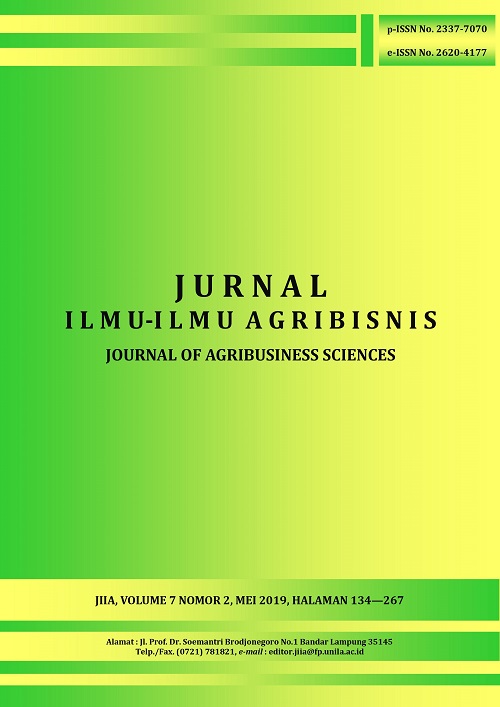EFISIENSI SISTEM PEMASARAN CENGKEH (Syzygium aromaticum) DI KABUPATEN PESISIR BARAT
DOI:
https://doi.org/10.23960/jiia.v7i2.3380 Abstract View: 903
Abstract View: 903
Abstract
This research aimed to analyze the efficiency of clove marketing system in Pesisir Barat Regency. The research data was collected in Karya Penggawa and Pesisir Utara Subdistrict of Pesisir Barat Regency in January – February 2017. This location was chosen purposively. Farmer respondents were chosen randomly, while marketing channel respondents were taken by tracing marketing networks. Data consisted of primary and secondary data. Data analysis included analysis of marketing system efficiency. The results showed that the marketing system of clove in Pesisir Barat Regency was inefficient with producer share (PS) 96.51%, with the following conditions as followed. The market structure was in imperfect competition (oligopsoni), clove farmers had no difficulty in marketing their product and there was one marketing channel in the market performance. Marketing margin was Rp3.157,46/kg and Ratio Profit Margin (RPM) 0.93%.
Key words: clove, efficiency, marketing system
Downloads
Downloads
Published
How to Cite
Issue
Section
License
Authors who publish with this journal agree to the following terms:
Authors retain copyright and grant the journal right of first publication with the work simultaneously licensed under a Creative Commons Attribution License that allows others to share the work with an acknowledgement of the work's authorship and initial publication in this journal.
Authors are able to enter into separate, additional contractual arrangements for the non-exclusive distribution of the journal's published version of the work (e.g., post it to an institutional repository or publish it in a book), with an acknowledgement of its initial publication in this journal.
Authors are permitted and encouraged to post their work online (e.g., in institutional repositories or on their website) prior to and during the submission process, as it can lead to productive exchanges, as well as earlier and greater citation of published work (See The Effect of Open Access).














